The Unfinished stories of other Kashmiri Pandits who refused to leave Kashmir in 1990!
(Kashmir Rechords Exclusive)
It has taken more than three decades, but a flicker of hope has returned to a family that has lived with grief, questions and silence. The Jammu and Kashmir Police’s State Investigation Agency (SIA) recently carried out raids at eight locations in Srinagar, probing the brutal killing of 27-year-old nurse Sarla Bhat in April 1990.Officials call these “strategic searches,” and say incriminating evidence has been found — the kind that could finally unravel the terrorist conspiracy that ended Sarla’s young life. For her family, the hope is simpler: justice, however delayed.
The SIA has now taken over the decades-old FIR No. 56/1990 from Police Station Nigeen. For those who have followed the long and painful journey of the Kashmiri Pandit exodus, this case is not just about one life lost — it is about hundreds of such stories swallowed by the chaos of 1990.
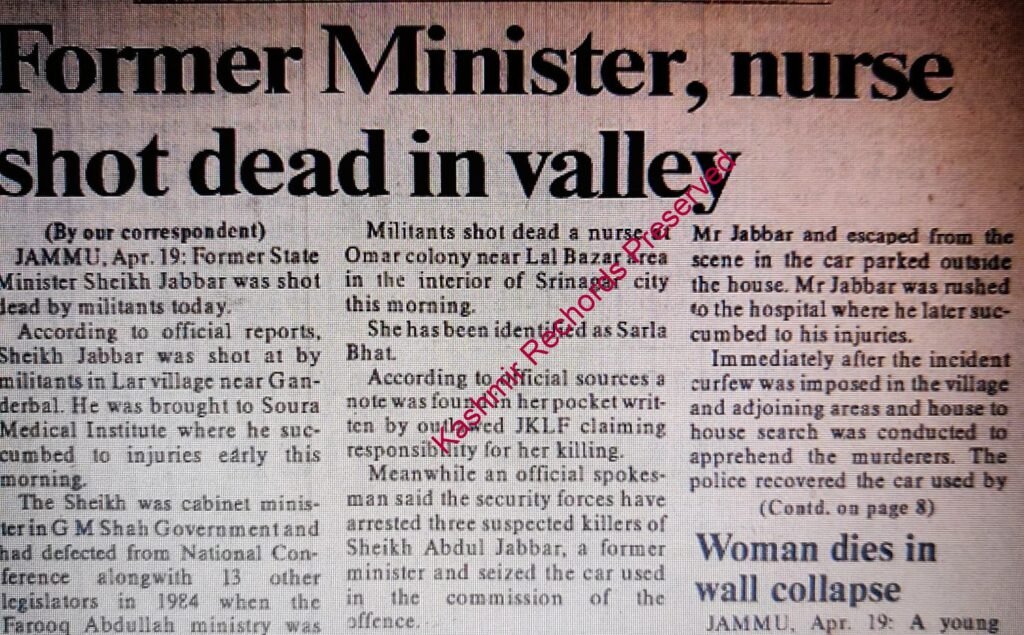
Sarla Bhat, like other Kashmiri Pandits, was no politician, no security official. She was a nurse at SKIMS Soura, Srinagar tending to patients in an already tense Kashmir. But in those early months of 1990, being a Kashmiri Pandit was enough to mark you as a “target.” On April 18, 1990, she was kidnapped from the Habba Khatoon Hostel of SKIMS. The next morning, her bullet-ridden body, according to a newspaper cutting dateline April 19, 1990, preserved by Kashmir Rechords, was found at Umar Colony, Lal Bazar. In her pocket lay a chilling note — the outlawed Jammu and Kashmir Liberation Front (JKLF) claiming responsibility.
Yet Sarla’s killing was only one in a relentless chain of murders that spring.
March to May 1990 — A Roll Call of the Lost
On March 22, 1990, Dr. Pushkar Nath, an officer in the J&K Agriculture Department, was gunned down in Bijbehara. The very next day, B.L. Karihaloo, who worked at a sweet shop, was shot dead in Bagat Kanipora. On March 26, 1990 Ashok Kumar of Safa Kadal met the same fate.
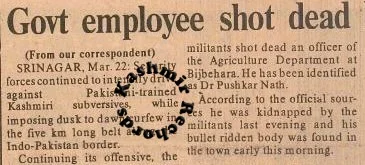
After Sarla’s death, the violence only escalated. On April 23, 1990 Sunil Kumar Kotru was killed in Rainawari, and police constable Dalip Singh’s body was recovered from Shopian. April 26, 1990 became a day of mass mourning, as six people — Ravinder Kumar, Bansi Lal Saproo, Mohd Ramzan, Ghulam Mohammad, Abdul Rehman, and Ghulam Rasool — were murdered across the Valley. By April 30, Moti Lal Pandita of Kupwara had joined the list of the dead.
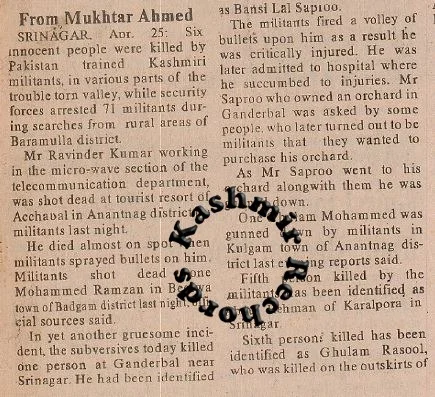
May month brought even more loss. On May 3, 1990 a Padma Shri-awarded Gujjar leader was shot dead in Bara Kasi, Tangmarg, followed by the killing of Police Inspector Chuni Lal Shalla in Langet, Sopore. On May 6, 1990 the bodies of Professor K.L. Ganjoo, his wife, and a young girl named Dolly were discovered. The violence peaked on May 11 with the assassination of former NC legislator Sheikh Manzoor.
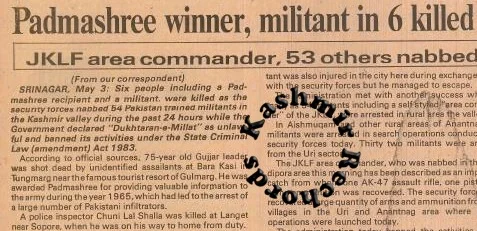
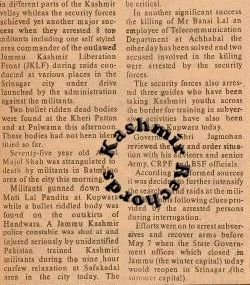
Some of these names appeared in the press, others barely made a ripple — yet each was a life cut short, each a family left without answers.
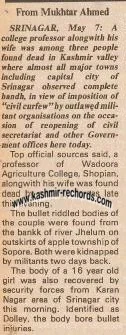
Why It Matters Now
For over three decades, these cases remained frozen in time, the files gathering dust while the survivors learned to live with silence. The reopening of Sarla Bhat’s case could — and should — be the start of revisiting all these unsolved murders, not just for the sake of legal closure, but for the dignity of those who can no longer speak for themselves.
Justice for Sarla Bhat would mean acknowledging the reality of that dark season: that ordinary Kashmiris, Pandit and Muslim alike, were killed in cold blood, and that their stories deserve more than a footnote in the history of 1990.
The SIA’s work might yet lead to convictions. But even before the courts deliver their verdict, there is a verdict we, as a society, must reach — that no matter how much time has passed, the lives taken in those months will not be forgotten.

